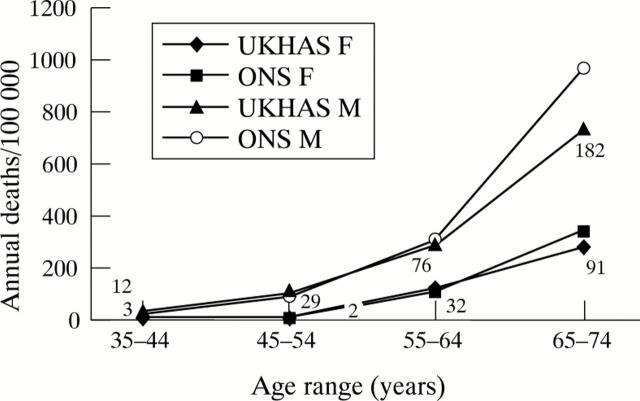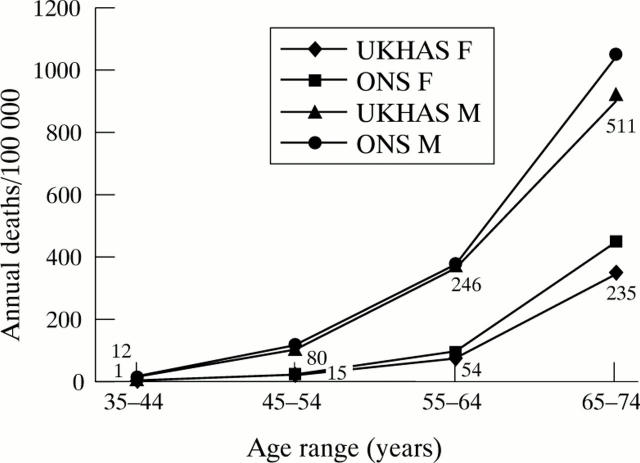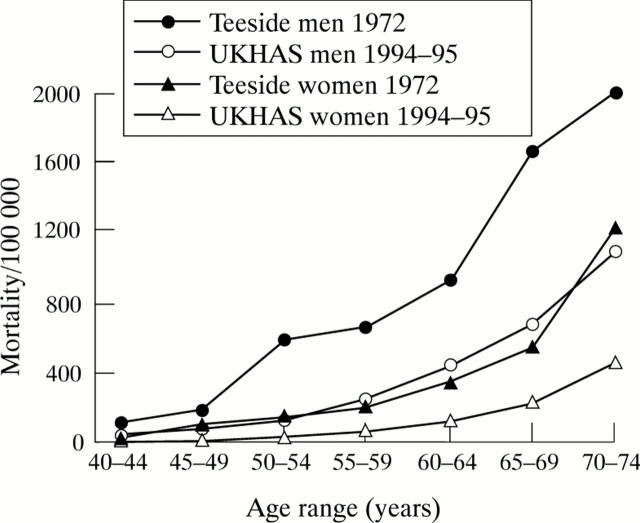Abstract
Objective—(1) To compare mortality estimates based on clinicopathological diagnoses of death from acute coronary heart disease with official estimates of coronary heart disease mortality; (2) to compare present day mortality figures with those from earlier reports. Design—Prospective community study over the two years 1994 and 1995. Setting—The health districts of Brighton, South Glamorgan, and York. Subjects—1589 men and women under 75 years of age who, based on our study criteria, died from acute coronary events were compared with certified cases of coronary death in the same age group. Main outcome measures—(1) Comparison of the underlying cause recorded on death certificates with the diagnosis of acute coronary death defined by our study criteria; (2) comparison of age specific mortality figures of the present with earlier studies. Results—Up to age 65, age specific mortality for coronary heart disease, using study criteria, was similar to official estimates. However, at ages 65-74 years there was a shortfall in study deaths of about 20% compared with official figures. One reason for this was that many death certificates in elderly people attributed death to coronary disease in the absence of confirmatory evidence. Despite this, deaths in the under 65 age group in the 1990s appear to be occurring in people who are about 10 years older than was the case during the 1970s. Conclusions—There are differences, most noticeable in elderly subjects, between estimates of coronary mortality made according to strict clinical and pathological definitions and official rates based on death certification. Recognition of these differences will be important for future epidemiological studies. Keywords: mortality; coronary heart disease; clinicopathological diagnosis; epidemiology
Full Text
The Full Text of this article is available as a PDF (135.0 KB).
Figure 1 .
Comparison of mortality in Brighton from acute coronary attacks calculated from results of the present study (UKHAS) with estimates calculated from death certificate data on the underlying cause of death provided by the Office of National Statistics (ONS). Figures refer to the number of study deaths in each age and sex group.
Figure 2 .
Comparison of mortality in South Glamorgan and York calculated from results of the UK heart attack study (UKHAS) with estimates calculated from cause of death from death certificates (ONS). Figures refer to the number of study deaths in each age and sex group.
Figure 3 .
Mortality/100 000 in men and women aged between 40 and 74 years reported from Teeside in 19729,16 compared with that calculated from United Kingdom heart attack study data during 1994-1995.
Selected References
These references are in PubMed. This may not be the complete list of references from this article.
- Armstrong A., Duncan B., Oliver M. F., Julian D. G., Donald K. W., Fulton M., Lutz W., Morrison S. L. Natural history of acute coronary heart attacks. A community study. Br Heart J. 1972 Jan;34(1):67–80. doi: 10.1136/hrt.34.1.67. [DOI] [PMC free article] [PubMed] [Google Scholar]
- Ashworth T. G. Inadequacy of death certification: proposal for change. J Clin Pathol. 1991 Apr;44(4):265–268. doi: 10.1136/jcp.44.4.265. [DOI] [PMC free article] [PubMed] [Google Scholar]
- Bonneux L., Looman C. W., Barendregt J. J., Van der Maas P. J. Regression analysis of recent changes in cardiovascular morbidity and mortality in The Netherlands. BMJ. 1997 Mar 15;314(7083):789–792. doi: 10.1136/bmj.314.7083.789. [DOI] [PMC free article] [PubMed] [Google Scholar]
- Colling A., Dellipiani A. W., Donaldson R. J., MacCormack P. Teesside coronary survey: an epidemiological study of acute attacks of myocardial infarction. Br Med J. 1976 Nov 13;2(6045):1169–1172. doi: 10.1136/bmj.2.6045.1169. [DOI] [PMC free article] [PubMed] [Google Scholar]
- Kinlen L. J. Incidence and presentation of myocardial infarction in an English community. Br Heart J. 1973 Jun;35(6):616–622. doi: 10.1136/hrt.35.6.616. [DOI] [PMC free article] [PubMed] [Google Scholar]
- Kircher T., Nelson J., Burdo H. The autopsy as a measure of accuracy of the death certificate. N Engl J Med. 1985 Nov 14;313(20):1263–1269. doi: 10.1056/NEJM198511143132005. [DOI] [PubMed] [Google Scholar]
- Maudsley G., Williams E. M. Death certification by house officers and general practitioners--practice and performance. J Public Health Med. 1993 Jun;15(2):192–201. [PubMed] [Google Scholar]
- Modelmog D., Rahlenbeck S., Trichopoulos D. Accuracy of death certificates: a population-based, complete-coverage, one-year autopsy study in East Germany. Cancer Causes Control. 1992 Nov;3(6):541–546. doi: 10.1007/BF00052751. [DOI] [PubMed] [Google Scholar]
- Morrison C., Woodward M., Leslie W., Tunstall-Pedoe H. Effect of socioeconomic group on incidence of, management of, and survival after myocardial infarction and coronary death: analysis of community coronary event register. BMJ. 1997 Feb 22;314(7080):541–546. doi: 10.1136/bmj.314.7080.541. [DOI] [PMC free article] [PubMed] [Google Scholar]
- Norris R. M. Fatality outside hospital from acute coronary events in three British health districts, 1994-5. United Kingdom Heart Attack Study Collaborative Group. BMJ. 1998 Apr 4;316(7137):1065–1070. [PMC free article] [PubMed] [Google Scholar]
- Pedoe H. T., Clayton D., Morris J. N., Brigden W., McDonald L. Coronary heart-attacks in East London. Lancet. 1975 Nov 1;2(7940):833–838. doi: 10.1016/s0140-6736(75)90233-0. [DOI] [PubMed] [Google Scholar]
- Pedoe H. T. Uses of coronary heart attack registers. Br Heart J. 1978 May;40(5):510–515. doi: 10.1136/hrt.40.5.510. [DOI] [PMC free article] [PubMed] [Google Scholar]
- Tunstall-Pedoe H., Kuulasmaa K., Amouyel P., Arveiler D., Rajakangas A. M., Pajak A. Myocardial infarction and coronary deaths in the World Health Organization MONICA Project. Registration procedures, event rates, and case-fatality rates in 38 populations from 21 countries in four continents. Circulation. 1994 Jul;90(1):583–612. doi: 10.1161/01.cir.90.1.583. [DOI] [PubMed] [Google Scholar]
- Watson P. S., Bensley D. C. Hypothesis that people with coronary heart disease are living longer is supported. BMJ. 1997 Jun 21;314(7097):1828–1828. doi: 10.1136/bmj.314.7097.1828. [DOI] [PMC free article] [PubMed] [Google Scholar]





